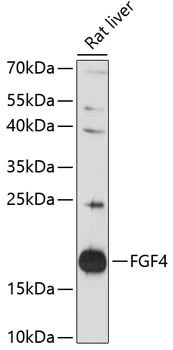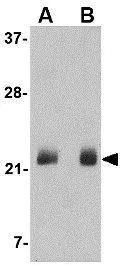![ELISA analysis of antigen using GTX60747 FGF4 antibody [2D7D5]. Black : Control antigen 100ng Purple : Antigen 10ng Blue : Antigen 50ng Red : Antigen 100ng ELISA analysis of antigen using GTX60747 FGF4 antibody [2D7D5]. Black : Control antigen 100ng Purple : Antigen 10ng Blue : Antigen 50ng Red : Antigen 100ng](https://www.genetex.com/upload/website/prouct_img/normal/GTX60747/GTX60747_20170912_ELISA_w_23061123_926.webp)
ELISA analysis of antigen using GTX60747 FGF4 antibody [2D7D5]. Black : Control antigen 100ng Purple : Antigen 10ng Blue : Antigen 50ng Red : Antigen 100ng
FGF4 antibody [2D7D5]
GTX60747
ApplicationsFlow Cytometry, Western Blot, ELISA
Product group Antibodies
TargetFGF4
Overview
- SupplierGeneTex
- Product NameFGF4 antibody [2D7D5]
- Delivery Days Customer9
- Application Supplier NoteELISA: 1/10000. *Optimal dilutions/concentrations should be determined by the researcher.Not tested in other applications.
- ApplicationsFlow Cytometry, Western Blot, ELISA
- CertificationResearch Use Only
- ClonalityMonoclonal
- Clone ID2D7D5
- ConjugateUnconjugated
- Gene ID2249
- Target nameFGF4
- Target descriptionfibroblast growth factor 4
- Target synonymsFGF-4, HBGF-4, HST, HST-1, HSTF-1, HSTF1, K-FGF, KFGF, SRTD22, fibroblast growth factor 4, heparin secretory transforming protein 1, heparin-binding growth factor 4, human stomach cancer, transforming factor from FGF-related oncogene, kaposi sarcoma oncogene, oncogene HST, transforming protein KS3
- HostMouse
- IsotypeIgG1
- Protein IDP08620
- Protein NameFibroblast growth factor 4
- Scientific DescriptionThe protein encoded by this gene is a member of the fibroblast growth factor (FGF) family. FGF family members possess broad mitogenic and cell survival activities and are involved in a variety of biological processes including embryonic development, cell growth, morphogenesis, tissue repair, tumor growth and invasion. This gene was identified by its oncogenic transforming activity. This gene and FGF3, another oncogenic growth factor, are located closely on chromosome 11. Co-amplification of both genes was found in various kinds of human tumors. Studies on the mouse homolog suggested a function in bone morphogenesis and limb development through the sonic hedgehog (SHH) signaling pathway. [provided by RefSeq, Jul 2008]
- Storage Instruction-20°C or -80°C,2°C to 8°C
- UNSPSC12352203

![FACS analysis of NIH3T3 cells using GTX60747 FGF4 antibody [2D7D5]. Green : FGF4 Red : negative control FACS analysis of NIH3T3 cells using GTX60747 FGF4 antibody [2D7D5]. Green : FGF4 Red : negative control](https://www.genetex.com/upload/website/prouct_img/normal/GTX60747/GTX60747_20170912_FACS_w_23061123_533.webp)
![WB analysis of HEK293 (1) and FGF4 (AA: 62-123)-hIgGFc transfected HEK293 (2) cell lysate using GTX60747 FGF4 antibody [2D7D5]. WB analysis of HEK293 (1) and FGF4 (AA: 62-123)-hIgGFc transfected HEK293 (2) cell lysate using GTX60747 FGF4 antibody [2D7D5].](https://www.genetex.com/upload/website/prouct_img/normal/GTX60747/GTX60747_20170912_WB_w_23061123_725.webp)





